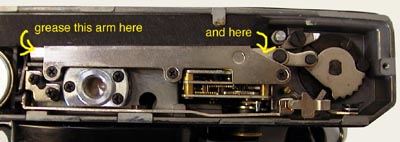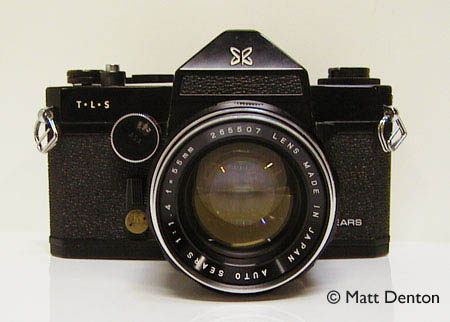- Produced circa 1967, Ricoh Co., Ltd. Japan
- Film type 135 (35mm)
- Picture size 24 x 36mm
- Weight 26.4oz (748.4g) body only; with Auto Sears 1.4/55mm lens 2 lbs, 5.6 oz (1.66kg)
- Lens M42 screw-mount Auto Sears (Rikenon) 1.4/55mm
- Filter size
- Shutter Copal metal square
- Shutter speeds B-1000 (sync at 1/125)
- Viewfinder SLR (fresnel, microprism)
- Exposure meter CdS with match needle, stop-down metering, on-off switch
- ASA settings 25-1600
- Battery originally 675 1.3v mercury
- PC X and M Sync terminals, optional accessory shoe
- Fast wind lever
- Siblings and close cousins aka Ricoh Singlex TLS; sold for Kmart as Focal TLX
Overview
Classic solid all-metal mechanical SLR made by Ricoh for Sears. Same as the Ricoh Singlex TLS but I like the styling of this particular black version enough to have looked for it over the functionally identical chrome Sears TLS and Ricoh Singlex TLS models, which are a little easier to find. I’ve also seen this same camera branded as “Cavalier” which apparently was the house brand of Willoughby’s Cameras in NYC back in the day (thanks Comrade Stoisha for the 411!). The TLS design is the screw-mount update to the camera that was the Nikkorex F, Ricoh Singlex (Nikon F-mount) and Sears SLII. The design was then licensed to Cosina who modified it slightly to create the highly underrated Cosina Hi-Lite. See the Argus/Cosina STL 1000 page for how this fits into camera history. I think TLS stands for Through Lens – Screw (mount) to denote the addition of TL metering (the Singlex/Nikkorex had a detatchable uncoupled CdS meter) and replacement of Nikon F-mount with screw-mount.
Speaking of acronyms and symbols, if you look closely at the butterfly logo you’ll see that it’s a stylized S and R for Sears-Roebuck. Or Sears-Ricoh?
Impressive features: rugged construction, fast glass, awesome shutter. The Copal Metal Square is my favorite mechanical shutter, it’s more dependable than rain on a holiday. Decades later they are strong and accurate, any camera that has one is in my opinion a cut above the rest, which makes cameras like this such a bargain. Another nice feature is the fast glass on this model. According to the manual there were available f2.8, f1.8, and f1.4 versions of the lens. This is my first f1.4 lens, a definite selling point for me when I was on the lookout. By the way, the Sears ‘manual’ for this camera is just a fairly generic user’s guide, practically a brochure, no real info at all about this camera that you couldn’t get from any other screw-mount SLR manual. Then again, the Ricoh manual doesn’t have too much more info.
Other features: CdS stop-down metering, ASA/speed dial is on the front (it was moved to the top in the Singlex II). I kind of like it there, just move your index finger down to turn it. No hot shoe, in fact mine didn’t even come with the accessory shoe. Sadly, the one from my Yashica J7 doesn’t fit on this one even though it did fit on my Argus/Cosina STL.
SO apart from the obvious and what I’ve mentioned there isn’t much else to say about it – it’s just a nice, solid, dependable all-mechanical SLR. Attractive too, I think.
Repairs
Meter not working. I suspect the usual – corroded ground wire from old mercury battery, but haven’t got around to looking yet. Also gummy light seals, including the foam mirror bumper which is beginning to leave naughty bits on the mirror. FOLLOWUP Took off the bottom cap and removed the battery chamber, it’s a self-grounding setup with one wire, everything clean as a pin. So I took off the lens mount and looked at the switch-meter wire, also intact. While I had the front apart, I scraped out the mirror bumper foam and glued in some film canister felt. Put it all back together and tried a new 625 battery again, and the meter jumped, and worked after a couple of minutes. I think now it was what I’ve heard referred to as ‘dry capacitor syndrome’, the system probably needs some charging up before working again after so many years.
Ah, a good one. I was showing a friend (who I think I’ve infected with the collecting bug) what a great camera this is, and after firing it several times in a row it jammed and wouldn’t wind. RATS! So I took it home and removed the bottom cap to see what was hanging up the wind stroke. I moved things around slowly until I found that a long sliding arm that was part of the stroke had too much friction and wasn’t sliding. I extended it by pulling on one end and lubed it with synthetic grease (from a bike shop), worked it a few times and then after winding and firing the shutter several times it was back to normal. A word of caution — if you’re messing around down here – the shutter cocks with a rack-and pinion mechanism, this sliding arm has teeth that draw across the gears for the shutter tensioning mechanism. If you remove the pressure plate that holds it in place (the bar with the three screws) you risk misaligning the sliding arm and if you do the shutter won’t cock after you reassemble it.

Tips & Tricks
Nothing you couldn’t figure out yourself, it’s a basic screw-mount match needle SLR with stop-down metering. Screw mount of course means you can take advantage of some of the best lenses ever made, and for very little money. Frankly, I’d rank this lens among them, it’s as sharp as a pin!
Related Links
- The Singlex TLS manual at www.butkus.org
- The Ricoh section of the helpful Screw Mount Page
- A Short History of the Copal square shutter
- Ricoh has short-sightedly removed historical camera info from the company’s history on its websites 🙁
